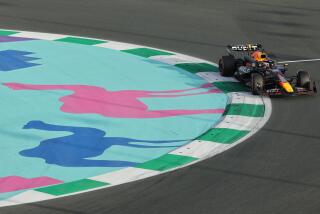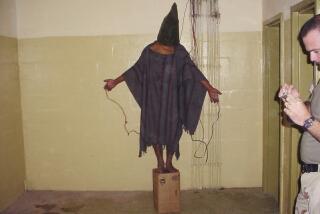Saudi Arabia tries to rehab radical minds
RIYADH, SAUDI ARABIA — Juma al-Dossari is returning to his life the way a photograph in a darkroom gradually takes shape on paper.
He is home after surviving six years and more than a dozen suicide attempts as a U.S. prisoner at Guantanamo Bay, Cuba. Courtyard walls have replaced barbed-wire fences, and Al-Dossari has completed what the Saudi government describes as a “soft approach” rehabilitation program to cleanse his mind, find him a wife, buy him a car and keep him happy so he doesn’t drift back toward Islamic fanaticism and jihad.
It is a strange, erratic journey toward self-discovery; Al-Dossari says he can Google his name and find descriptions of a man he no longer knows, but he’s still unsure about what kind of man he will become.
“We can’t go immediately from getting off a plane from Cuba to living in society. Everything has changed,” said Al-Dossari, a nervous, wiry 34-year-old in a checkered kaffiyeh. “There are more streets, bridges and buildings here than I remember. I was gone a long time. My driver’s license expired while I was in Guantanamo. My father died. Now, I’m trying to get things back on track.”
The other day, Al-Dossari sat on a long couch at the Care Rehabilitation Center with fellow released Guantanamo detainees. They wore pressed white tunics. Some spoke in broken English learned from their former captors; others were thin and still recovering from what Saudi doctors described as torture and trauma. Several of the men smiled as if posing for a family portrait, disguising the rage and bewilderment of lost years and wondering how to fit back into their native land, which was welcoming but suspicious.
This religiously rigid kingdom, a key U.S. ally that has been battling Islamic terrorist networks for years, is known for harsh imprisonment and interrogation tactics that often draw condemnation from human rights groups.
But for three years, the Interior Ministry has been trying to turn impressionable militants away from radicalism through six weeks of psychological counseling, religious reeducation, job training and art therapy that can produce Jackson Pollock knock-offs and stark desert scenes. Those who complete the program, such as Al-Dossari, receive outreach counseling and are kept under surveillance.
“We have to deal with the minds and the emotional passions of the extremists,” said Turki Otayan, a psychologist at the center, which has treated 1,500 alleged militants, including more than 100 released this year from Guantanamo. “Fixing minds is like fixing a building with 60 floors. It’s not easy.”
Psychologists, sheiks and Interior Ministry officials occasionally allow reporters to visit the center and talk to detainees. There is an aura of public relations to the trip, but also a sense of mission to quell extremism in a country that produced Osama bin Laden and most of the Sept. 11 hijackers. With its strict tribal codes and devotion to Wahhabi Islam, Saudi Arabia understands the motivations and warped passions of young men willing to ignite holy war across the globe, and increasingly, within the kingdom.
Most of the men in the program were arrested in Saudi Arabia or in neighboring countries while attempting to travel to Iraq and Afghanistan. Since the U.S.-led invasion of Iraq in 2003, terrorist attacks across the kingdom, some aimed at Western targets, have killed nearly 150 people. A recent nationwide raid captured 208 alleged militants, some of whom were planning attacks on oil installations. Saudi media reported that police also discovered eight Chinese-made missiles that purportedly were to be fired at hotels and other buildings.
‘Building trust’
The new rehabilitation program is aimed at militants who haven’t entirely crossed over to nihilism. The program is calculated to change the image of Saudi Arabia as an exporter of terrorists while restoring dignity and confidence to misguided young Islamists who can then help lead others away from radical websites and bloody international ventures.
“We start building trust between us and them,” Gen. Yousef Mansour, spokesman for the Interior Ministry, said while sitting near a former militant who had been burned and disfigured in an Iraqi bombing. “There’s no need for handcuffs. These guys are broken inside.”
The center, a grid of low-lying buildings on the wind-swept outskirts of Riyadh, the capital, does not resemble a prison, except for an occasional glint of razor wire coiling above rose bushes and small soccer fields. Metal courtyard doors open to bearded faces, some smiling, some bemused. Some of the men make ink drawings, others dab paint and pastels to sketch a ship or a map of their country.
There is pingpong, lunch on the grass and Islamic lectures by Sheik Ahmed Jelan, a heavyset, jovial man who strolls the grounds in brown robes trimmed in gold.
He told the men sitting before him on school chairs that they had violated the Koran by not following the four conditions of holy war, including receiving permission from the leader of their nation and ascribing to a just and clear cause. He noted that Islamic tenets had been perverted by Bin Laden and other terrorists, whom he referred to as “gang leaders, not true Muslims.”
He added, “If you don’t follow the four conditions, you go to hell, not heaven.”
The message -- Bin Laden is castigated with fervor here -- was part of the rehabilitation center’s pervading mantra: The militants were led astray by corrupted ideals, and only state- approved imams and sheiks can interpret the true meanings of the Koran. It is the same theme the government has been spreading to villages and rural outposts in hopes of undercutting the allure radical Islam has for young men with limited opportunities.
“Bin Laden doesn’t have the proper religious education to control so many people,” said Mohammed Fozan, a computer technician who was arrested in Syria in 2005 on his way to build websites for Islamic militants in Iraq. He was extradited to Saudi Arabia and placed in the rehabilitation program. Today, he works as a computer programmer in the Transportation Ministry while he fixes up a house and waits for his family to choose his bride.
“I just want to get on with my life,” he said, eating fish and chicken with sheiks and security officials, the likes of whom years earlier he despised as supporters of the infidel West’s war against Islam. “When I adopted that radical way of thinking, it was without analysis. I just took it because I felt a responsibility for all those Iraqis dying.”
He glanced down at his plate and smiled. “You could say the government cleaned the hard drive of my mind. There were bad viruses and things in there.”
Free from Guantanamo
Former Guantanamo detainees possess a quieter, more subtle air than reformed militants such as Fozan. Many of them deny they were extremists and, although not wanting to discuss how they ended up in Cuba, say they were victims of circumstance. One man said he was on a rug-buying trip to Afghanistan when he was arrested; another said he was on a humanitarian mission to repair mosques when he was taken prisoner with Taliban fighters.
U.S. authorities say the men were “enemy combatants” who enlisted to fight with Islamic militants. The Pentagon has been repatriating Saudi prisoners and those of other nationalities over the last year under international pressure to free Guantanamo detainees who had not been charged with war crimes.
Christopher Boucek, a Princeton professor doing postdoctoral research on counter-terrorism strategies, lauded the Saudi rehabilitation program as a logical, cost-effective and long-term approach to dealing with the tens of thousands of war-on-terrorism prisoners the U.S. has detained around the world.
“This isn’t a problem they can jail their way out of or shoot their way out of,” Boucek said of the conflict and the teeming U.S.-run prisons in Iraq, Afghanistan, Guantanamo and elsewhere.
Bukhari Abdul Hakim, a round-faced man with a graying mustache whose conversation is punctuated by long pauses, spent six years at Guantanamo. He was one of 133 Saudi prisoners, including three who died, at the island jail. Hakim lost his construction job, became diabetic and missed the birth of his granddaughter. He wants to get married, but sometimes he confuses things; he despises the United States.
“The American government is a liar,” Hakim said. “Why did they keep me all those years? I’m not an enemy combatant. I’m not a terrorist. . . . I don’t want to talk about that time. I want to talk about now. My country. Everything is good.”
But amid the good there’s a gloom he can’t quite shake. “What can I do? I have nothing,” he said. “My government will help me buy a car so I can become a taxi driver. I’m 54 years old. I’m an old man. I can’t do anything.”
Juma al-Dossari, who has joint Saudi-Bahraini citizenship, has drawn pictures and talked to counselors about how to move beyond his Guantanamo years, which began with his arrest in 2001 on the Pakistani-Afghan border. He spoke of the “bad ideals” of radicalism, of how Bin Laden “used my religion and destroyed its reputation,” of how he is trying to “fix” himself but sometimes seems lost.
“Before all this happened, I lived in Indiana in 2000,” he said. “I worked in an Islamic center for a while. I like Indiana. I like American life. There is a difference between real Americans and those guys who run Guantanamo. I have to be fair, though. Some of the guards at Guantanamo were kind. They apologized to me.”
He sat in a room where videos and slide shows were shown earlier depicting the rehabilitation center’s successes. He wants to be one but seems not to want to sound programmed or rehearsed.
Voices of other men murmured just beyond his, all recounting their ordeals as the sheiks, psychologists and Interior Ministry officials lingered at the edges until the day was done. He did not mention his suicide attempts, including one in which he slit an artery in his neck.
“I cannot forget those six years,” Al-Dossari said. “When the airplane came to take us back home, it was like a dream, a dream from prison to Saudi paradise.”
--
Times staff writer Carol J. Williams in Guantanamo Bay contributed to this report.
More to Read
Sign up for Essential California
The most important California stories and recommendations in your inbox every morning.
You may occasionally receive promotional content from the Los Angeles Times.











